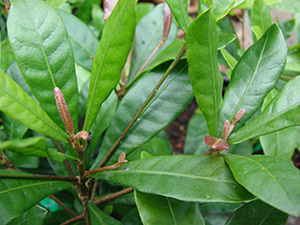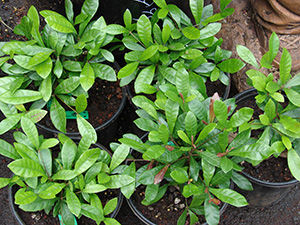Miracle Fruit

Photo courtesy of Forest and Kim Starr.
Alternative, natural sweeteners are all the rage as we search for sweet flavors without the calories. One that has emerged as a “miraculous” solution is miracle fruit or “sour to sweet” fruit. This fruit is unique in that it isn’t particularly flavorful on its own, but anything consumed after the berries will taste sweet! Miracle fruit is being considered for use as an alternative sweetener and as a solution for chemotherapy patients who suffer from tasting metallic flavors as they undergo treatment. Although it’s native to West Africa, miracle fruit can grow in Florida gardens too.
Characteristics
Miracle fruit (Synsepalum dulcificum) is a slow-growing evergreen bush that’s capable of reaching great heights, although it tends to be small in Florida. Leaf appearance and size varies, but they tend to be two to four inches long and half an inch to over an inch wide. They may be flat, wavy, or curved. The flowers are small, white, and borne in small clusters. They lead to small, red berries that are just shy of an inch long. The oval-shaped fruits contain a thin layer of flesh surrounding a seed.
To experience the magic of the berry, pop one in your mouth and gently chew around the seed. You can spit out the seed once it’s separated from the fruit. Continue moving the flesh and skin around your mouth to fully coat your tongue. The pulp contains a protein called “miraculin” that temporarily alters the taste receptors on the tongue, causing sour flavors to register as sweet instead. Now, try something sour to test it! Biting a slice of lemon is a good way to start. The effect will last between fifteen minutes to an hour, so you have plenty of time to put miracle fruit to the test.

Photo courtesy of Forest and Kim Starr.
Planting and Care
Miracle fruit is not frost tolerant and requires soil that is slightly acidic (a pH of around five is ideal), so it’s best to grow it in a container in Florida. You can increase acidity by irrigating with rainwater or adding coffee grounds to the soil. Using a pine-based potting mix works well also. In a container, the plant can be brought inside when a freeze is on the horizon, and you can easily control the soil composition. You can also grow miracle fruit in the ground in South Florida as long as you don’t plant it in alkaline soil. Regardless of how you grow it, choose a location that has full sun to partial shade.
Regularly apply fruit fertilizer throughout the warm parts of the year to keep your miracle fruit bush happy. Supplemental irrigation is also beneficial during dry periods. No major diseases have been identified as a problem yet, but mealy bugs and mites could appear. The experts at your county Extension office can help with any pest issues.

Photo courtesy of Forest and Kim Starr.
Start looking for fruits once your plant reaches three years old. Fruit production will peak at about the five-year mark, and annual pruning will encourage maximum fruiting. If you end up harvesting more fruit than you can use at once, freeze or freeze-dry the extra. Don’t worry, the sour-to-sweet properties will be preserved.
For more advice on growing miracle fruit, contact the experts at your county Extension office.

